


How do I know if an athlete’s power output would be best enhanced by increasing their force or velocity capabilities? How do I know if an athlete would benefit most from increasing their peak force or their rate of force development (RFD)? These are two questions strength and conditioning (S&C) professionals will ponder when planning strength training to support athletic performance.
The dynamic strength index (DSI) has been proposed as a diagnostic approach to help answer such questions. This article discusses the suitability of both the denominator (isometric peak force) and numerator (jump peak force) metrics, and the DSI ratio itself, to inform programming decisions. Drawing on biomechanical principles and research exploring the physiology of condition-specific strength, we outline its disputable underpinnings. Accordingly, alternative diagnostic tools are proposed. Together with an understanding of the specific constraints on force production within target sporting actions, these will in turn help practitioners to make the most informed decision on the best strength training approach to enhance their athletes’ physical performance.
The ability to produce and attenuate force at various magnitudes and velocities is critical for maximising sports performance.[59] Most sporting actions rely on an ability to express force in a limited time frame, with ground contact times reported to be < 100 ms during the stance phase of near maximal sprint running[9,73] and 120-300 ms during early accelerative sprint running, cutting and jumping.[1,33,56,67,73] Furthermore, the ability to rapidly re-stabilise joints following mechanical perturbation is essential to prevent joint injuries, given anterior cruciate ligament ruptures have been shown to occur within the first 50m of ground contact.[25,41] Therefore, an athlete’s rate of force development (RFD) is of high importance for both athletic performance and injury risk mitigation.[37,38]
Additionally, many sporting actions also rely on an ability to produce force at high movement velocities and contraction speeds. For instance, hip and knee velocities during sprint running have been reported in the region of 426-660 rads/s, respectively.[58]
Thus, both RFD and an ability to produce force at high muscle shortening velocities are of great relevance to athletic performance. Further to this, the peak force an athlete can achieve (ie, their maximum strength) is also important since this sets the upper limit to which RFD scales,[30] and will influence the full spectrum of the force- velocity continuum.[52] Accordingly, the following are two prominent questions strength and conditioning (S&C) professionals will ponder when planning strength training to support athletic performance:
1. How do I know if an athlete’s power output would be best enhanced through increasing their force or velocity capabilities?
2. How do I know if an athlete would benefit most from increasing their peak force or their RFD?
To maximise comprehension of this article, a table of working definitions are provided in Table 1. These definitions are important as they help us to delineate the mechanical determinants of force expression under varying constraints, which in turn, help practitioners understand the true meaning of various assessment data. For example, although inter-related, available time-frame and movement (muscle fascicle shortening) velocity pose different constraints on force production. In other words, they present different conditions which, to borrow Zatsiorsky’s term,[74] influence an athlete’s ‘strength potential’ in different ways. Force expression in some actions (eg, those involving overcoming inertia via a build-up of force from net zero within a limited time-window) will be more constrained by relative force/ RFD (eg, SJ), whereas others (eg, those where there is a pre-existing level of force already built-up or where the limb is already moving at an angular velocity high enough to compromise further force production) will be more constrained by the force-velocity relationship (eg, CMJ).
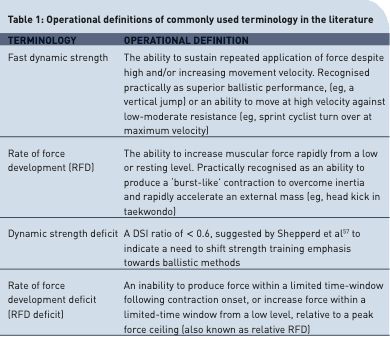
It has been suggested that an athlete’s strength training history is likely a major factor in determining whether pursuing maximal strength, fast dynamic strength, or RFD would be most beneficial.[64] This makes sense considering athletes with greater strength training histories will typically have greater relative force capabilities, which determines acceleration and resultant velocity in locomotive tasks. However, further strength diagnostics have been proposed to address these questions with greater rigour.]57,61] The Dynamic Strength Index (DSI), in particular, compares an athlete’s peak force within a dynamic condition (ie, a jump), with their peak force achieved in an isometric condition (ie, isometric mid-thigh pull [IMTP]). For example, if an athlete produced a peak force of 1500 Newtons (N) in the jump and 2500 N in an isometric task, the resultant DSI (1500 ÷ 2500) would be 0.60. Based on the original study using 18 male and female athletes conducted by Sheppard et al,57 it has more recently been suggested that those with a DSI < 0.6 should focus on ballistic strength training, whereas those with a ratio > 0.8 should focus on maximal strength training.62
However, it is important to note the original authors acknowledged the limitations of the ratio,[57] outlining that athletes with low relative strength would likely gain most from developing this, irrespective of the ratio value. Table 2 exemplifies why the ratio should always be interpreted in context. For instance, peak force is low in athlete C, despite the ballistic training indication and high in athlete D, despite the heavy strength training indication. This highlights how consideration of the component parts is necessary to ensure assumptions of the ratio data are not misleading, which has been suggested in a recent editorial.[10]
Both the IMTP and isometric squat can be used to obtain an athlete’s maximal force-generating capacity, although they shouldn’t be used interchangeably in practice due to higher peak forces typically attained in the isometric squat.[17,19] Notwithstanding, the IMTP will be referred to for the remainder of this article, given that it seems to be more commonly utilised in DSI research studies.[19,39] The dynamic component is usually represented by either a squat jump (SJ) or a countermovement jump (CMJ), and dependably yields a lower peak force than the isometric condition.
The aim of this article is to critique the DSI as a diagnostic tool used to determine: a) whether an athlete’s power output would be best enhanced through increasing their force or velocity capabilities, and b) whether increasing their peak force or their RFD would have most benefit. In other words, can the DSI inform whether pursuing maximal strength, fast dynamic strength or RFD would be most beneficial to maximise an athlete’s strength potential for given task conditions? Since we highlight issues with the efficacy of the DSI, alternative tools are then proposed in the practical applications section. These should assist practitioners in choosing more valid protocols to guide decision-making on the specific strength qualities lacking in athletes, in the context of the conditions imposed by their sporting actions.

Does jump peak force reflect an athlete’s fast dynamic strength capability?
As discussed in the introduction, the test typically used torepresent thedynamic component of the DSI is a SJ or a CMJ; therefore, both need to be considered when addressing this question. The SJ push-off is initiated from a fixed static starting position, meaning the athlete is at net force zero at the start of the propulsive phase. This static start means the average propulsive velocity is not as high as in a CMJ,[27] where force will be much higher at the start of the push-off to counteract the downward acceleration of the athlete’s mass (see Figure 1).[70]

So, does the ability to achieve a higher peak force in either the SJ or CMJ reflect superior fast dynamic strength? Firstly, it is clear that peak force does not directly equate to ballistic capability (eg, how high an athlete jumps), as it does not irrefutably explain take-off velocity in the same way as net impulse relative to body mass[44] – which is what underpins how high an athlete jumps.[5,51] Peak force and jump height may even be at odds as both variables are confounded by displacement. This is demonstrated in Figure 2, which compares the force- time, and displacement-time traces of two CMJs. The CMJ displacement-time trace shows a greater displacement (area under the curve) in CMJ-B which – as reflected in the force-time trace – results in a greater net impulse (effective work), despite a lower peak force. This explains why mean force (SJ: 1560.37 ± 210.18 vs. CMJ: 1186.08 ± 132.69) and peak force (SJ: 2103.19 ± 378.04 vs. CMJ: 2069.82 ± 258.59) can be higher than in the SJ, despite significantly lower jump heights.[27] Therefore, whereas jump performance outcome metrics such as jump height, take-off velocity or impulse will reflect fast dynamic strength capabilities, peak force in isolation does not. Research undertaken by Suchomel et al.[60] supports this conclusion as they found weak correlations between jump peak force and the DSI (r = 0.297 in males and r = 0.313 in females, respectively), while IMTP peak force and the DSI was strongly related (r = 0.848 in males and r = 0.746 in females, respectively). This suggests jump peak force may be somewhat superfluous and it is the IMTP peak force which has most bearing on the resultant DSI ratio.
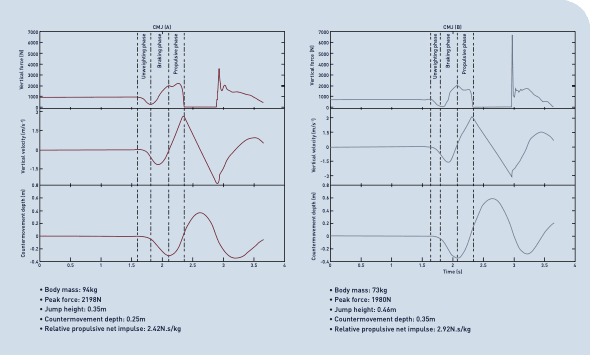
Does the DSI ratio inform whether maximal or fast dynamic strength should be emphasised?
As mentioned within the introduction, maximal strength, or the peak force an athlete is able to achieve, is likely to influence the full spectrum of the force-velocity continuum.[52] Indeed, there is evidence that maximal strength training will serve to improve power output across the entire continuum by shifting the whole force-velocity curve to the right.[20,21,22,42] However, as the target sporting action(s) move closer to the velocity-end of this continuum, the less influence maximal strength training is likely to have on power output in that task and the more important it becomes to pursue distinct, speed-related training adaptations (ie, maximal muscle fibre shortening velocity, and task-specific coordination). This is the reason why S&C coaches often ponder whether the training emphasis should be on increasing peak force or fast dynamic strength, particularly in athletes with substantial strength training histories. The training status of the individual is important because of the host of adaptations that increase strength: there are a number which will have a negative effect on the velocity end of the force-velocity continuum. These include muscle fibre transformation from type IIX to type IIA,4 and hypertrophic changes which increase the muscle’s internal moment arm.[48] However, in weak individuals, other adaptations which shift the entire force-velocity continuum to the right, such as favourable alterations in motor unit recruitment and increases in muscle volume, may outweigh the negative effects of the aforementioned force-orientated adaptations.
Overlooking the fact that we have established jump peak force is not the best reflection of fast dynamic strength (as per our definition in Table 2), the DSI is proposed to guide the S&C coach towards the best training strategy. However, the aforementioned limitations of CMJ jump peak force as a metric is a threat to the premise of the ‘dynamic strength deficit’, as the peak force exhibited will depend on their jump strategy (eg, countermovement depth, etc.).[49] This makes the generalised interpretation guidelines (> 0.80 = heavy resistance training; < 0.60 = ballistic training) inherently flawed. With regards to the SJ, the fixed starting position helps matters somewhat by constraining the athlete’s strategy, but to strictly control for displacement, one would also have to account for differences in vertical push- off distance as a result of an athlete’s anthropometrics. Notwithstanding, for this reason the SJ likely offers more value to track or observe change in an individual.
Researchers have previously hypothesised an association between an athlete’s DSI and the slope of their force- velocity continuum.[53,60] However, one cannot reliably make inferences about an athlete’s force-velocity orientation because in order to determine this relationship, one variable (force or velocity) must be controlled while the other is manipulated.15 Clearly, this is not the case in the DSI. Rather, peak force attained in the jump essentially reflects their ability to produce force at the specific aspect of the force- velocity curve which is afforded by their jumping ability. This may partly explain why Scheller et al55 found negligible associations between the DSI ratio and the slope of the force-velocity profile (r2 = 0.01), together with the biomechanical differences between the jumping and IMTP tasks. From this perspective, the DSI ratio is not a discerning metric to evaluate an athlete’s force-velocity orientation. However, the IMTP component does offer the basic insight of unveiling the athlete’s maximal force ceiling/relative strength, which may help identify at what point an increased focus on fast dynamic strength training is justified.
Does jump peak force reflect an athlete’s RFD capabilities?
To the authors’ knowledge, and somewhat surprisingly, there is a scarcity of research exploring the relationship between peak force and RFD during jumping. McLellan et al45 reported a strong correlation at r = 0.63, suggesting RFD may account for ~40% of the variance (r2) in peak force. Although not exactly the same, Kawamori et al[40] reported associations between CMJ peak force and peak RFD in mid-thigh clean pulls at a range of intensities (r = 0.52 at 120% intensity, r = 0.35 at 90% intensity, r =0.22 at 60% intensity, and r = 0.51 at 30% intensity). The lack of consistency in these findings is likely a consequence of the erratic and unreliable nature of RFD as a metric,[18,46] together with the methodological differences in how RFD is calculated. For example, McLellan et al[45] reports peak RFD calculated from the maximum force that occurred over the first derivative of the force-time curve and Kawamori et al[40] reports peak RFD using a 0.002 mins moving time-window. Additionally, neither study clarified whether this was taken from the braking or propulsive phase, which are not comparable as peak force would occur earlier in the latter.[65] Consequently, the different ways by which RFD is calculated makes it challenging to gain any consistent insight into the relationship between vertical jump peak force and RFD.
Given this complexity, it seems logical to revert to first principles. The first limitation we highlight has been discussed already in the context of dynamic strength – ie, the metric is confounded by displacement or jump strategy. A practical way to infer dynamic RFD improvements (ie, during a jump), would be to concurrently monitor the metric of ‘time to take-off’, in addition to the force or impulse from a jump. A reduction in time-to-take-off with no increase in force or impulse would then indicate the athlete is achieving the same outcome, in less time; therefore, RFD has likely improved. Clearly, without the metric of time to take-off, this inference is impossible. As was the case for dynamic strength, the jump type will have a large bearing on the relationship between jump peak force and RFD. As previously discussed, the pre-existing high levels of force at the start of the propulsive phase in a CMJ reflect the fact the muscles have built up a high stimulation during the downward phase to create pre-tension in the musculotendinous unit. This affords greater joint moments over the early joint extension, and in turn, the ability to perform more work in the first part of the CMJ push-off phase.[13,14] As a consequence of this, the need for a rapid rise in force at the start of the push-off phase is negated. Therefore, peak force from a CMJ is likely a poor reflection of an athlete’s RFD capabilities. In fact, it is viable that the peak force may occur at zero velocity, so the RFD during the propulsive phase of the jump may even be negative.
On the other hand, peak force achieved in a SJ will somewhat reflect RFD capabilities, as it will directly influence the area under the force-time curve during the propulsive phase. However, it is worth noting that peak force typically occurs earlier (approximately 125-150 ms) in explosive concentric contractions because the high initial neuromuscular activation persists for longer than in other muscle activity types.[65] This therefore reduces the ‘impulse advantage’ of a greater RFD, as maximal strength (peak force) and specifically, the force that can be maintained at the specific aspect of the force-velocity curve, will have the greatest influence on the area under the force-time curve. Therefore, if using the SJ as the dynamic component of the DSI, one could theoretically infer some change in RFD within an athlete over time (assuming the IMTP peak force value remained stable), but this should be interpreted with caution as any improvements may be explained to a greater proportion by changes in the athlete’s force-velocity orientation (improved ability to produce greater force at the velocity-end).
Does the DSI ratio inform whether peak force or RFD should be emphasised?
From a contractile point of view, peak force and RFD are inextricably linked, as the latter will scale to the former.[1,26,30] However, from a neural standpoint the two properties can be uncoupled.[6,23,26,29] Indeed, 300 Hz is required to drive a muscle to its maximal RFD (23), while maximal voluntary force is usually achieved at much lower frequencies (eg, 30-50 Hz).[8] Additionally, recruitment thresholds are lower in ballistic tasks such as jumping.[23,26] Therefore, on a neural level, training to enhance RFD would require different adaptations, and as such training approaches (eg, increasing motor unit firing frequency at force onset via explosive/ ballistic training) than aiming to develop maximal strength, via neural adaptations (eg, increases in motor unit recruitment from high force training), at least in trained individuals.[29,66] This is the reason why S&C coaches often ponder whether the training emphasis should be on increasing peak force or RFD, particularly in athletes with substantial strength training histories. However, matters are complicated by the fact that although maximal strength and RFD-orientated training will induce different functional adaptations, there are also many shared physiological determinants (eg, muscle size, muscle contractile properties and neuromuscular activation – particularly recruitment).[4,26,29,64] Ultimately, the relative influence of the distinct factors underpinning RFD vs the shared determinants underpinning both RFD and maximal strength will depend on the duration and phase of contraction.
Aside from the matter of specifying task conditions, can the DSI ratio help answer this question? Authors of a recent study hypothesised that the DSI ratio and a ratio obtained from a comparison of peak force vs force at early epochs within an IMTP (referred to herein as relative RFD) embody similar constructs.[49] However, within the component parts of the DSI, the early force time-point from contraction onset is not fixed, as the peak force in the jump will vary between individuals and thus, once again, make the interpretation guidelines non-generalisable. Secondly, the time to take-off in a SJ and a CMJ has been reported at 415 ms and 448 ms, respectively.[2] Granted, force production will be constrained by velocity here as well as time, but the contraction phase is still likely too long to have distinct determinants to the IMTP, as peak force has been found to explain 75% of the variance in explosive force by 100 ms and 90% by 150 ms.[30] Subsequently, this is somewhat of a meaningless relative RFD inference, as more divergent contraction phases would be needed to represent two force-time points which represent distinct neuromuscular/ mechanical capacities.[28] This issue would be compounded with the use of a CMJ as opposed to a SJ, as while the force at the start of the SJ will be equal to bodyweight (as long as executed correctly), the values will not be at net zero at the equivalent point in a CMJ.[13,14]
Therefore, to conclude, the DSI ratio is not a suitable metric to inform the practitioner whether the athlete would reap most benefit from RFD or maximal strength training emphasis. However, as discussed previously, the peak force value taken alone may provide some insight as a high value is likely to reflect superior relative strength which once adequate may again justify a focus away from maximal strength, and towards RFD as well as fast dynamic strength.
Determining training strategy: Maximal strength vs fast dynamic strength emphasis
This article has highlighted that the DSI ratio and the associated guidelines are based on disputable concepts. A simpler way to evaluate whether an athlete’s power output would be best enhanced through increasing their force or velocity capabilities, would be to run a load-velocity profile. This has the advantage of plotting jump outcome metrics against an independently manipulated load, as opposed to a force value (used in the DSI), which is inextricably linked to velocity, and confounded by displacement. This makes interpretation more straightforward. Jump height (or take- off velocity) can be plotted across a spectrum of loading conditions (eg, body mass (BM), BM+25%, BM+50%, BM+75%, BM+100%). An athlete who is relatively strong (but does not jump high) may be classified as velocity deficient, while an athlete who is relatively weak (but jumps high) may be classified as force deficient. The Bosco Index= previously applied the same method to just the two extreme loads (BW and BW+100%), with higher indexes associated with greater force orientations. This is unlike peak force, since external load/system mass will not be influenced by propulsive velocity (the athlete’s jumping capabilities), where the data is more comparable between athletes.
Despite these advantages of load- velocity profiling over the DSI, it is important we accept the profile as being task-specific. Indeed, there are movement specificities which will influence the relationship, such as inertia and inclination,[52] meaning the most favourable load-velocity curve and associated load-specific coordination is unique to the sporting action.[58,72] Additionally, due to the fact dynamic strength is exhibited when the limbs are already moving at high velocities, it is highly reliant on coordination and therefore, the neural adaptations responsible for improvements (motor unit firing frequency and synchronisation, antagonist coactivation, etc) may not have benefit to different movements. This means unless the profile is conducted in the target task (eg, acceleration load- velocity profile for a 100m sprinter) the data may lack construct validity. Finally, we must also acknowledge the possibility of measurement error when using linear position transducers.[47]
Determining training strategy: Maximal strength or RFD?
Having established that aside from the IMTP component unveiling an athlete’s maximal force ceiling, the DSI ratio is not a particularly valuable guide to answer this question. As discussed, obtaining reliable RFD values can prove challenging,[18,46] particularly when force onset identification is required (eg, 0-100ms).[18] Therefore, an alternative, practitioner-friendly method to infer RFD may be to obtain force at specific time points from contraction onset (eg, force at 100 ms, 200 ms, etc);[35,64] then, this needs to be scaled to the ultimate peak force (within the same isometric task), to infer how quickly the slope is rising, (referred to herein as relative RFD).[18,64,67] The evidence suggests using an epoch of ≤ 100 ms,[6,12,18,23,26,67] as this represents a time-point post contraction-onset where RFD will have a substantial effect on the net impulse, and where the force value achieved will be dependent on factors distinct to maximal strength. The earlier the epoch, the greater influence RFD is likely to have, but reliability appears to suffer at early time-points (CV =20% at 50 ms)[18] during the IMTP, improving to acceptable CV values (6.5-11%) at 90 ms.[31,32,46] Based on this research, it is advisable to avoid taking force-time data much before the 100 ms time- point to inform practice (despite its theoretical value). Figure 3 shows a comparison of relative RFD data across three athletes.
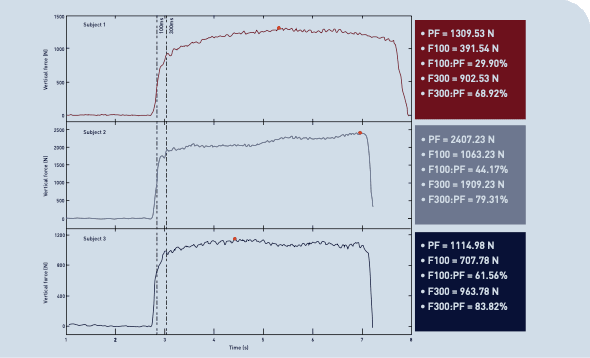
More research is needed to establish normative data for relative RFD to enable the practitioner to infer an RFD deficit with confidence. Indeed, the threshold for what is considered a ‘deficit’ may depend on the athlete’s sport and of course demographics such as age and gender. Table 3 summarises relative RFD values from five studies reporting both peak force and force at between 90-100 ms in the IMTP, with mean values ranging from 43-58%. Beckham et al[7] reported individual subject data from 12 weightlifters, with a range of relative RFD from 31- 57%. Based on the existing evidence, it appears 50% would be a good general benchmark to aim for. However, sport- specific data should ideally be obtained and practitioners are encouraged to establish their own norms over time, and monitor meaningful change on an individual basis.
Although the aforementioned reliability challenges are not abolished at 100 ms, should relative RFD have clear value as a programming tool, practitioners are encouraged to overcome this by using multiple trials on different days to rigorously check between-day variability, enabling some level of confidence as to what the true ‘noise’ is for such early force-time windows.[68]

Logic-led approaches
Should a representative load-velocity profile not be feasible, and relative RFD not be particularly relevant to the target sporting action, we are left with logic- led approaches. For instance, as long as adequate group-specific data has been accumulated, the orientation of training focus according to an athlete’s strengths and weaknesses could even be gleaned without ratio data, which carries inherent drawbacks.[9] This would simply involve contrasting whatever assessments have been chosen (based on being most relevant to the sporting actions) to gauge force and velocity or ballistic capabilities. For example, CMJ positive impulse and IMTP have regularly been used to classify athletes according to these orientations within golf.[11,71] The authors appreciate this does not precisely denote an athlete’s force-velocity orientation, but it has been suggested that from the available evidence, directing training to rectify a theoretical force-velocity imbalance should come second to simply addressing both force and velocity ends of the curve to enhance power.[42] Similarly, through simple regression analysis, practitioners can observe up to what point increases in maximal strength (ie, peak force) influence ballistic performance (ie, jump height or impulse). In turn, when transfer of benefits seemingly starts to diminish, one could assume an increased focus on ballistic training is justified.
With all these alternative options in mind, Table 4 outlines alternative tools that could be used to answer the two questions posed at the start of this article. Ultimately, it is undeniable that all strength assessments have a degree of task-specificity, so practitioners are advised to make every effort to precisely specify the conditions surrounding force production within their athletes’ sport, before determining which metrics and associated ratio data are valid. RFD is likely to be highly reliant on maximal strength in tasks with larger time-windows (ie, > 150 ms), such as jumping and high angle (ie, > 60 degrees) changes of direction running.
However, maximal strength will be less influential in tasks with very short time- frames (ie, < 100 ms) such as maximal sprint running, which will have a greater reliance on neuromuscular activation and raw (speed-related) contractile properties. Moreover, fast dynamic strength will be more relevant for sporting actions that utilise non- contractile tissues to generate and preserve energy (maximal sprint running). Therefore, understanding both the temporal and mechanical factors in the target task is fundamental to making the most informed decision on where to focus an athlete’s strength training programme.
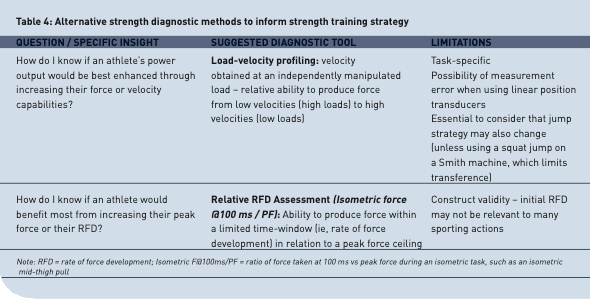
The numerator metric of jump peak force creates significant drawbacks to the DSI as a diagnostic tool. Whereas jump height reflects fast dynamic strength capabilities, SJ or CMJ jump peak force in isolation does not. SJ peak force has advantages for observing within-athlete changes in RFD capabilities over time, but this will still only explain a portion of any change. The generalised interpretation guidelines attached to the DSI ratio are highly disputable, as jump peak force will be dependent on individual jump strategy (CMJ) or confounded by anthropometric factors (SJ). The DSI ratio does not reflect an athlete’s force-velocity orientation and there are more efficacious diagnostic tools for informing strength training strategy.
Although maximal strength, fast dynamic strength and RFD have some shared determinants, the task conditions constraining force production will determine the relative importance and reliance on each. It remains advisable to consider an athletes’ maximal force ceiling as a starting point to forming a strength training strategy, as this is likely to determine the need for more sophisticated diagnostics. Any further diagnostics should investigate fast dynamic strength and RFD capabilities separately – as suggested in recent empirical studies[49,60] – as these represent somewhat distinct/condition- specific qualities.
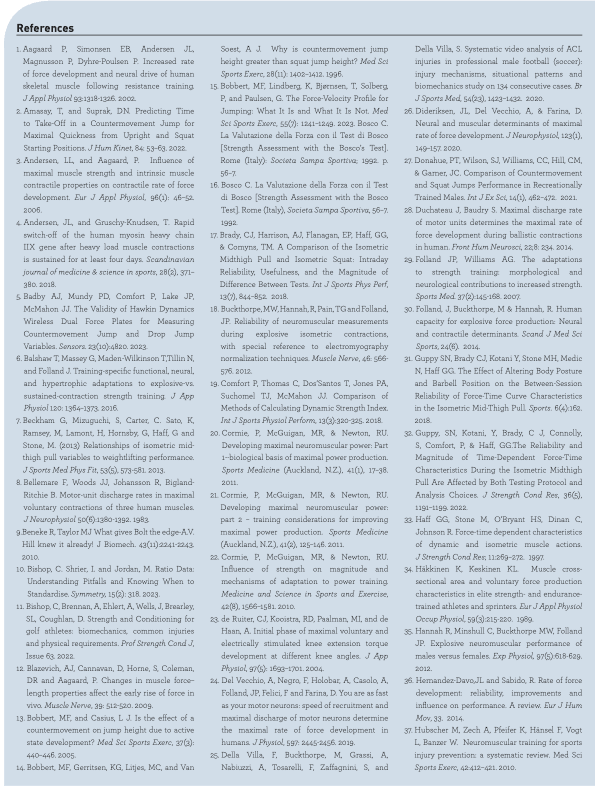
1. Aagaard P, Simonsen EB, Andersen JL, Magnusson P, Dyhre-Poulsen P. Increased rate of force development and neural drive of human skeletal muscle following resistance training. J Appl Physiol 93:1318-1326. 2002.
2. Amasay, T, and Suprak, DN. Predicting Time to Take-Off in a Countermovement Jump for Maximal Quickness from Upright and Squat Starting Positions. J Hum Kinet, 84: 53–63. 2022.
3. Andersen, LL, and Aagaard, P. Influence of maximal muscle strength and intrinsic muscle contractile properties on contractile rate of force development. Eur J Appl Physiol, 96(1): 46–52. 2006.
4. Andersen, JL, and Gruschy-Knudsen, T. Rapid switch-off of the human myosin heavy chain IIX gene after heavy load muscle contractions is sustained for at least four days. Scandinavian journal of medicine & science in sports, 28(2), 371– 380. 2018.
5. Badby AJ, Mundy PD, Comfort P, Lake JP, McMahon JJ. The Validity of Hawkin Dynamics Wireless Dual Force Plates for Measuring Countermovement Jump and Drop Jump Variables. Sensors. 23(10):4820. 2023.
6. Balshaw T, Massey G, Maden-Wilkinson T,Tillin N, and Folland J. Training-specific functional, neural, and hypertrophic adaptations to explosive-vs. sustained-contraction strength training. J App Physiol 120: 1364–1373. 2016.
7. Beckham G, Mizuguchi, S, Carter, C. Sato, K, Ramsey, M, Lamont, H, Hornsby, G, Haff, G and Stone, M. (2013) Relationships of isometric midthigh pull variables to weightlifting performance. J Sports Med Phys Fit, 53(5), 573-581. 2013.
8. Bellemare F, Woods JJ, Johansson R, BiglandRitchie B. Motor-unit discharge rates in maximal voluntary contractions of three human muscles. J Neurophysiol 50(6):1380-1392. 1983.
9.Beneke R, Taylor MJ What gives Bolt the edge-A.V. Hill knew it already! J Biomech. 43(11):2241-2243. 2010.
10. Bishop, C. Shrier, I. and Jordan, M. Ratio Data: Understanding Pitfalls and Knowing When to Standardise. Symmetry, 15(2): 318. 2023.
11. Bishop, C, Brennan, A, Ehlert, A, Wells, J, Brearley, SL, Coughlan, D. Strength and Conditioning for golf athletes: biomechanics, common injuries and physical requirements. Prof Strength Cond J, Issue 63. 2022.
12. Blazevich, AJ, Cannavan, D, Horne, S, Coleman, DR and Aagaard, P. Changes in muscle force– length properties affect the early rise of force in vivo. Muscle Nerve, 39: 512-520. 2009.
13. Bobbert, MF, and Casius, L J. Is the effect of a countermovement on jump height due to active state development? Med Sci Sports Exerc, 37(3): 440–446. 2005.
14. Bobbert, MF, Gerritsen, KG, Litjes, MC, and Van Soest, A J. Why is countermovement jump height greater than squat jump height? Med Sci Sports Exerc, 28(11): 1402–1412. 1996.
15. Bobbert, MF, Lindberg, K, Bjørnsen, T, Solberg, P, and Paulsen, G. The Force-Velocity Profile for Jumping: What It Is and What It Is Not. Med Sci Sports Exerc, 55(7): 1241–1249. 2023. Bosco C. La Valutazione della Forza con il Test di Bosco [Strength Assessment with the Bosco’s Test]. Rome (Italy): Societa Sampa Sportiva; 1992. p. 56–7.
16. Bosco C. La Valutazione della Forza con il Test di Bosco [Strength Assessment with the Bosco Test]. Rome (Italy), Societa Sampa Sportiva, 56–7. 1992.
17. Brady, CJ, Harrison, AJ, Flanagan, EP, Haff, GG, & Comyns, TM. A Comparison of the Isometric Midthigh Pull and Isometric Squat: Intraday Reliability, Usefulness, and the Magnitude of Difference Between Tests. Int J Sports Phys Perf, 13(7), 844–852. 2018.
18. Buckthorpe, MW, Hannah, R, Pain, TG and Folland, JP. Reliability of neuromuscular measurements during explosive isometric contractions, with special reference to electromyography normalization techniques. Muscle Nerve, 46: 566- 576. 2012.
19. Comfort P, Thomas C, Dos’Santos T, Jones PA, Suchomel TJ, McMahon JJ. Comparison of Methods of Calculating Dynamic Strength Index. Int J Sports Physiol Perform, 13(3):320-325. 2018.
20. Cormie, P, McGuigan, MR, & Newton, RU. Developing maximal neuromuscular power: Part 1--biological basis of maximal power production. Sports Medicine (Auckland, N.Z.), 41(1), 17–38. 2011.
21. Cormie, P, McGuigan, MR, & Newton, RU. Developing maximal neuromuscular power: part 2 – training considerations for improving maximal power production. Sports Medicine (Auckland, N.Z.), 41(2), 125–146. 2011.
22. Cormie, P, McGuigan, MR, & Newton, RU. Influence of strength on magnitude and mechanisms of adaptation to power training. Medicine and Science in Sports and Exercise, 42(8), 1566–1581. 2010.
23. de Ruiter, CJ, Kooistra, RD, Paalman, MI, and de Haan, A. Initial phase of maximal voluntary and electrically stimulated knee extension torque development at different knee angles. J App Physiol, 97(5): 1693–1701. 2004.
24. Del Vecchio, A, Negro, F, Holobar, A, Casolo, A, Folland, JP, Felici, F and Farina, D. You are as fast as your motor neurons: speed of recruitment and maximal discharge of motor neurons determine the maximal rate of force development in humans. J Physiol, 597: 2445-2456. 2019.
25. Della Villa, F, Buckthorpe, M, Grassi, A, Nabiuzzi, A, Tosarelli, F, Zaffagnini, S, and Della Villa, S. Systematic video analysis of ACL injuries in professional male football (soccer): injury mechanisms, situational patterns and biomechanics study on 134 consecutive cases. Br J Sports Med, 54(23), 1423–1432. 2020.
26. Dideriksen, JL, Del Vecchio, A, & Farina, D. Neural and muscular determinants of maximal rate of force development. J Neurophysiol, 123(1), 149–157. 2020.
27. Donahue, PT, Wilson, SJ, Williams, CC, Hill, CM, & Garner, JC. Comparison of Countermovement and Squat Jumps Performance in Recreationally Trained Males. Int J Ex Sci, 14(1), 462–472. 2021.
28. Duchateau J, Baudry S. Maximal discharge rate of motor units determines the maximal rate of force development during ballistic contractions in human. Front Hum Neurosci, 22;8: 234. 2014.
29. Folland JP, Williams AG. The adaptations to strength training: morphological and neurological contributions to increased strength. Sports Med. 37(2):145-168. 2007.
30. Folland, J, Buckthorpe, M & Hannah, R. Human capacity for explosive force production: Neural and contractile determinants. Scand J Med Sci Sports, 24(6). 2014.
31. Guppy SN, Brady CJ, Kotani Y, Stone MH, Medic N, Haff GG. The Effect of Altering Body Posture and Barbell Position on the Between-Session Reliability of Force-Time Curve Characteristics in the Isometric Mid-Thigh Pull. Sports. 6(4):162. 2018.
32. Guppy, SN, Kotani, Y, Brady, C J, Connolly, S, Comfort, P, & Haff, GG.The Reliability and Magnitude of Time-Dependent Force-Time Characteristics During the Isometric Midthigh Pull Are Affected by Both Testing Protocol and Analysis Choices. J Strength Cond Res, 36(5), 1191–1199. 2022.
33. Haff GG, Stone M, O’Bryant HS, Dinan C, Johnson R. Force-time dependent characteristics of dynamic and isometric muscle actions. J Strength Cond Res; 11:269–272. 1997.
34. Häkkinen K, Keskinen KL. Muscle crosssectional area and voluntary force production characteristics in elite strength- and endurancetrained athletes and sprinters. Eur J Appl Physiol Occup Physiol, 59(3):215-220. 1989.
35. Hannah R, Minshull C, Buckthorpe MW, Folland JP. Explosive neuromuscular performance of males versus females. Exp Physiol, 97(5):618-629. 2012.
36. Hernandez-Davo,JL and Sabido, R. Rate of force development: reliability, improvements and influence on performance. A review. Eur J Hum Mov, 33. 2014.
37. Hubscher M, Zech A, Pfeifer K, Hänsel F, Vogt L, Banzer W. Neuromuscular training for sports injury prevention: a systematic review. Med Sci Sports Exerc, 42:412–421. 2010.
38. Izquierdo M, Aguado X, Gonzalez R, Lopez JL, Hakkinen K. Maximal and explosive force production capacity and balance performance in men of different ages. Eur J Appl Physiol Occup Physiol, 79:260–267. 1999.
39. James LP and Comfort P. The reliability of novel, temporal-based dynamic strength index metrics Sports Biomech, 1-12. 2022.
40. Kawamori, N, Rossi, SJ, Justice, BD, Haff, GG, Pistilli, EE, O’Bryant, H. S., Stone, M. H., & Haff, GG. Peak force and rate of force development during isometric and dynamic mid-thigh clean pulls performed at various intensities. J Strength Cond Res, 20(3): 483–491. 2006.
41. Krosshaug, T, Nakamae, A, Boden, BP, Engebretsen, L, Smith, G, Slauterbeck, JR, Hewett, TE, & Bahr, R. Mechanisms of anterior cruciate ligament injury in basketball: video analysis of 39 cases. Am J Sports Med, 35(3): 359–367. 2007.
42. Lindberg, K, Solberg, P, Rønnestad, BR, et al. Should we individualize training based on force-velocity profiling to improve physical performance in athletes? Scand J Med Sci Sports, 31: 2198–2210. 2021.
43. Lum, Danny & Chua, Kelvin & Aziz, Abdul Rashid. Isometric mid-thigh pull force-time characteristics: A good indicator of running performance. J Trainology, 9. 54-59. 10.17338/ trainology.9.2: 54. 2020.
44. McBride, J Kirby, T, & Skinner, J. Relationship Between Relative Net Vertical Impulse and Jump Height in Jump Squats Performed to Various Squat Depths and With Various Loads. Int J Sports Phys Perf, 5(4) 484-496. 2010.
45. McLellan CP, Lovell DI, Gass GC. The role of rate of force development on vertical jump performance. J Strength Cond Res, 25(2):379-385. 2011.
46. Moeskops, S, Oliver, JL, Read, PJ, Cronin, JB, Myer, GD, Haff, GG, & Lloyd, RS. Within- and Between-Session Reliability of the Isometric Midthigh Pull in Young Female Athletes. J Strength Cond Res, 32(7), 1892–1901. 2018.
47. Moreno-Villanueva, A, Pino-Ortega, J, & RicoGonzález, M. Validity and reliability of linear position transducers and linear velocity transducers: a systematic review. Sports Biomechanics, 1–30. Advance online publication. 2021.
48. Nagano, A, and Komura, T. Longer moment arm results in smaller joint moment development, power and work outputs in fast motions. Journal of Biomechanics, 36(11), 1675–1681. https://doi. org/10.1016/s0021-9290(03)00171-4. 2003.
49. Ong, Keng & Chua, Kelvin & Lum, Danny. Relationship Between Dynamic Strength Index and Early Force Production of Isometric MidThigh Pull. J Sci Sport Ex, 10. 2024.
50. Pleša, J., Kozinc, Ž., Bishop, C., & Šarabon, N. Association Between Dynamic Strength Index Derived from Isometric Squat and Squat Jump or Countermovement Jump and Force-Velocity Profile. Measurement in Physical Education and Exercise Science, 28(1), 57–65. 2024.
51. Ruddock AD, Winter EM. Jumping depends on impulse not power. J Sports Sci, 34(6):584-585. 2016.
52. Samozino, P, Edouard, P, Sangnier, S, Brughelli, M, Gimenez, P, and Morin, JB. Force-velocity profile: imbalance determination and effect on lower limb ballistic performance. Int J Sports Med, 35(6), 505–510. 2014.
53. Samozino, P, Rejc, E, Di Prampero, PE, Belli, A, & Morin, JB. Optimal force-velocity profile in ballistic movements--altius: citius or fortius?. Med Sci Sports Exerc, 44(2), 313–322. 2012.
54. Schantz P, Randall-Fox E, Hutchison W, Tydén A, Astrand PO. Muscle fibre type distribution, muscle cross-sectional area and maximal voluntary strength in humans. Acta Physiol Scand, 117(2):219-226. 1983.
55. Scheller, Coleman & Peeler, Jason & Duhamel, Todd & Cornish, Stephen. The Relationship between Components of the Dynamic Strength Index and the Slope of the Force-Velocity Profile in the Loaded Countermovement Jump in Resistance-Trained Males and Females. International Journal of Strength and Conditioning, 3. 2023.
56. Schmidtbleicher D. Training for power events. In: Komi, PV. The Encyclopedia of Sports Medicine. Vol 3: Strength and Power in Sport; Oxford, UK: Blackwell,169–179. 1992.
57. Sheppard, J, Chapman, D, and Kristie-Lee, T. An Evaluation of a Strength Qualities Assessment Method for the Lower Body. J Aus Strength Cond, 19: 4-10. 2011.
58. Slawinski J, Bonnefoy A, Ontanon G, et al. Segment-interaction in sprint start: Analysis of 3D angular velocity and kinetic energy in elite sprinters. J Biomech, 43(8):1494-1502. 2010.
59. Suchomel TJ, Nimphius S, Stone MH. The importance of muscular strength in athletic performance. Sports Med 46: 1419–1449. 2016.
60. Suchomel TJ, Sole CJ, Bellon CR, Stone MH. Dynamic Strength Index: Relationships with Common Performance Variables and Contextualization of Training Recommendations. J Hum Kinet, 74:59-70. 2020.
61. Tidow G. Aspects of strength training in athletics. New Stud Athl, 1:93-110. 1990.
62. Thomas, C, Jones, PA, and Comfort, P. Reliability of the Dynamic Strength Index in college athletes. Int J Sports Phys Perf, 10(5): 542–545. 2015.
63. Thorstensson A, Karlsson J, Viitasalo HT, Luhtanen P, Komi PV. Effect of strength training on EMG of human skeletal muscle. Acta Physiol Scand 98: 232–236. 1976.
64. Tillin NA, Jimenez-Reyes P, Pain MT, Folland JP. Neuromuscular performance of explosive power athletes versus untrained individuals. Med Sci Sports Exerc, 42:781-790. 2010.
65. Tillin NA, Pain MTG, Folland JP. Contraction speed and type influences rapid utilisation of available muscle force: neural and contractile mechanisms. J Exp Biol, 221. 2018.
66. Tillin, NA, and Folland, JP. Maximal and explosive strength training elicit distinct neuromuscular adaptations, specific to the training stimulus. Eur J App Phys, 114(2), 365–374. 2014.
67. Tillin, NA, Pain, MT, and Folland, J. Explosive force production during isometric squats correlates with athletic performance in rugby union players. J Sports Sci, 31(1), 66–76. 2013.
68. Turner, AN, Brazier, J, Bishop, C, Chavda, S, Cree, JA, & Read, PJ. Data Analysis for Strength and Conditioning Coaches: Using Excel to Analyze Reliability, Differences, and Relationships. Strength Cond J, 37, 76–83. 2015.
69. Van Custem M, Duchateau J, Hainaut K. Changes in single motor unit behaviour contribute to the increase in contraction speed after dynamic training in humans. J Physiol 1998.
70. Van Hooren B, Zolotarjova J. The Difference Between Countermovement and Squat Jump Performances: A Review of Underlying Mechanisms With Practical Applications. J Strength Cond Res, 31(7):2011-2020. 2017.
71. Wells JET, Charalambous LH, Mitchell ACS, et al. Relationships between Challenge Tour golfers’ clubhead velocity and force producing capabilities during a countermovement jump and isometric mid-thigh pull. J Sports Sci 37(12):1381- 1386. 2019.
72. West, D, Owen, N, Jones, M, Bracken, R, Cook, C, Cunningham, D, Shearer, D, Finn, C, Newton, R, Crewther, B, Kilduff, L. Relationships Between Force–Time Characteristics of the Isometric Midthigh Pull and Dynamic Performance in Professional Rugby League Players. J Strength Cond Res 25(11), 3070-3075. 2011.
73. Weyand, P, Sternlight, D, Bellizzi, M and Wright, S. Faster top running speeds are achieved with greater ground forces not more rapid leg movements. Journal of Applied Physiology, 89(5): 1991-1999. 2000.
74. Zatsiorsky VM. Task Specific Strength, in: Science and Practice of Strength Training. Champaign, IL: Human Kinetics,21-58. 1995.
75. Zatsiorsky V and Kramer W. Science and Practice of Strength Training. (2nd ed). Champaign, IL: Human Kinetics. 2006.

A consultant in elite sport with expertise in both performance rehabilitation and the strength & conditioning - skill acquisition interface, Simon works with athletes looking to unlock higher performance levels. He has a specialism in golf but works with athletes from all sports to restore physical qualities following musculoskeletal health problems.

Matt is a Senior Lecturer who has published more than 35 peer-reviewed research papers. Matt joined St Marys in 2020, following his PhD and having spent nearly 10 years working in the industry.

Currently working on research using quantitative biomechanical analysis to investigate jump performance and its association with athletic performance.

Chris has published over 250 peer-reviewed publications, edited two text books and is currently on the Medical and Scientific Committee for the R&A, DP World Tour and Ladies European Tour, in professional golf. Chris is also a former Board Director and Chair of the UKSCA.